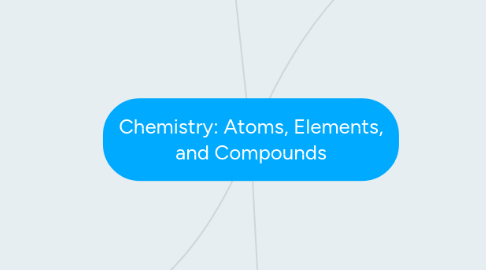
1. The Atom
1.1. Important Discoveries that Shaped Atomic Theory
1.1.1. John Dalton
1.1.1.1. Matter is made of small invisible atoms
1.1.1.2. Atoms of an element are identical in properties
1.1.1.3. Atoms of different elements have different properties
1.1.1.4. Atoms of different elements can combine to form new substances
1.1.2. J.J Thomson
1.1.2.1. Used a cathode ray
1.1.2.2. Discovered electrons
1.1.2.3. Argued that all elements contain electrons
1.1.2.4. Atoms were composed of smaller particles
1.1.2.5. Created Thomson's model
1.1.3. Earnest Rutherford
1.1.3.1. Shot positive charged particles at pure gold
1.1.3.2. Discovered the nucleus
1.1.3.3. Revised Thomson's model
1.1.4. James Chadwick
1.1.4.1. Discovered neutrons
1.1.4.2. Discovered protons
1.1.4.3. Each neutron carries about the same mass as each proton.
1.1.5. Niels Bohr
1.1.5.1. Created Bohr diagrams
1.1.5.2. Shows that electrons reside in shells and jump between each shell by gaining or losing electrons
1.1.5.3. First shell has a maximum of two electrons
1.1.5.4. Every other shell has a maximum of eight electrons
1.1.6. Quantum Mechanical Model: electrons exist in specific energy levels as a cloud
1.2. The Elements
1.2.1. Alloys are a mixture of two or more metals
1.2.2. Metals: shiny, silver or grey in colour, great conductors, and malleable.
1.2.3. Non-metals: there are only 17 elements
1.2.4. Metalloids have metallic and non-metallic properties and are semi-conductors.
1.3. A Summary of the Atom
1.3.1. Protons
1.3.1.1. Resides in the nucleus
1.3.1.2. Has an electric charge of 1+
1.3.1.3. Has a relative mass of 1836
1.3.2. Neutrons
1.3.2.1. Resides in the nucleus
1.3.2.2. Has an electric charge of 0
1.3.2.3. Has a relative mass of 1837
1.3.3. Electrons
1.3.3.1. Resides in energy levels surrounding the nucleus.
1.3.3.2. Has an electric charge of 1-
1.3.3.3. Has a relative mass of 1
1.4. The Element Symbols
1.4.1. Each element has its own symbol
1.4.2. First letter is capital and the second is lowercase.
1.5. The Periodic Table
1.5.1. Atomic number
1.5.2. Atomic mass
1.5.3. Ions
1.5.4. Periods
1.5.5. Groups
2. Ionic Compounds
2.1. Atomic theory supports the periodic table
2.2. Group 1 elements lose 1 electron (1+ charge) Group 2 elements lose 2 electrons (2+ charge) Group 3-12 elements lose different numbers of electrons Group 13 elements lose 3 electrons (3+ charge) Group 14 elements can lose or gain 4 electrons (4+ 4- charge) Group 15 elements gain 3 electrons (3- charge) Group 16 elements gain 2 electrons (2- charge) Group 17 elements gain 1 electron (1- charge) Group 18 elements gain no electrons (0)
2.3. Lewis structures show the valence electrons of an atom.
2.4. Ionic compounds
2.4.1. High melting points
2.4.2. forms crystals
2.4.3. dissolves in water
2.4.4. becomes said at room temperature
2.5. Naming Ionic Compounds
2.5.1. First element stays the same
2.5.2. Second element ends in "ide"
3. Matter
3.1. What is Matter?
3.1.1. 3 states: solid, liquid, and gas
3.1.2. Matter can change between the 3 states: solid to liquid (melting), liquid to gas (evaporation), gas to liquid (condensation), liquid to sold (freezing), solid to gas (sublimation), and gas to solid (deposition)
3.1.3. Particle theory of matter: matter is composed of tiny objects called particles, particles have space between them, particles are always in motion, and particles in a substance attract each other.
3.2. Classifying Matter
3.2.1. Classifies as a pure substance or a mixture
3.2.2. Pure substances are either elements or compounds. Elements can't be broken down by chemicals and compounds are made by the formation of two or more elements.
3.2.3. Mixtures can be heterogenous or homogenous. Heterogenous mixtures can be seen with different, homogenous mixtures look the same throughout, and suspension is a mixture in which tiny particles of a substance are held in another.
3.3. Physical Properties
3.3.1. Can be easily reversed
3.3.2. Colour and lustre
3.3.3. Density
3.3.4. Hardness
3.3.5. Viscosity
3.4. Chemical Properties
3.4.1. Chemical reaction
3.4.2. Chemical change
3.4.2.1. Results in the formation of a new substace
3.4.2.2. cannot be reversed easily
3.4.2.3. Combustibility
4. Molecular Compounds
4.1. Properties
4.1.1. formed when non-metals combine
4.1.2. can be any of the 3 states at room temperature
4.1.3. good insulators, poor conductors
4.1.4. Low boiling points
4.2. Naming molecular compounds
4.2.1. First element always stays the same
4.2.2. second element changes to end in "ide"
4.3. Writing formulas
4.3.1. Identify symbol of first element
4.3.2. Identify symbol of second element
4.3.3. Add subscripts to indicate the amount
